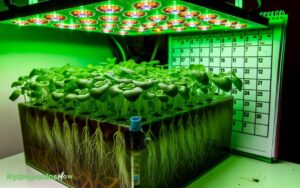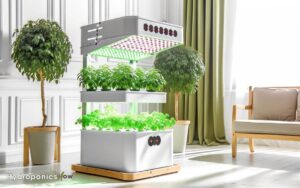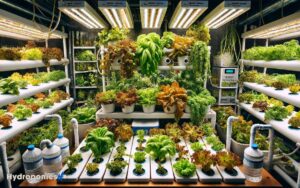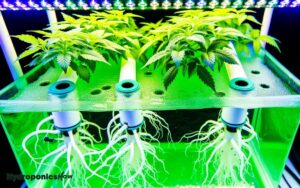How to Provide Fundamental Elements Plants Need to Grow in Hydroponics
In hydroponics, plants need precise levels of macronutrients such as nitrogen (100-150 ppm), phosphorus (30-50 ppm), and potassium (200-400 ppm) for best growth.
Also, essential are calcium (150-400 ppm), magnesium, and sulfur (20-40 ppm). Regularly monitor pH levels, aiming for a range of 5.5-6.5.
Proper water quality is essential, maintaining total dissolved solids (TDS) and ensuring sufficient dissolved oxygen (DO) levels. Micronutrients like iron, zinc, and manganese are also important.
Precise conditions help create a balanced nutrient solution, essential for hydroponic success. Discovering the nuanced balance will further enhance your hydroponic efficiency.
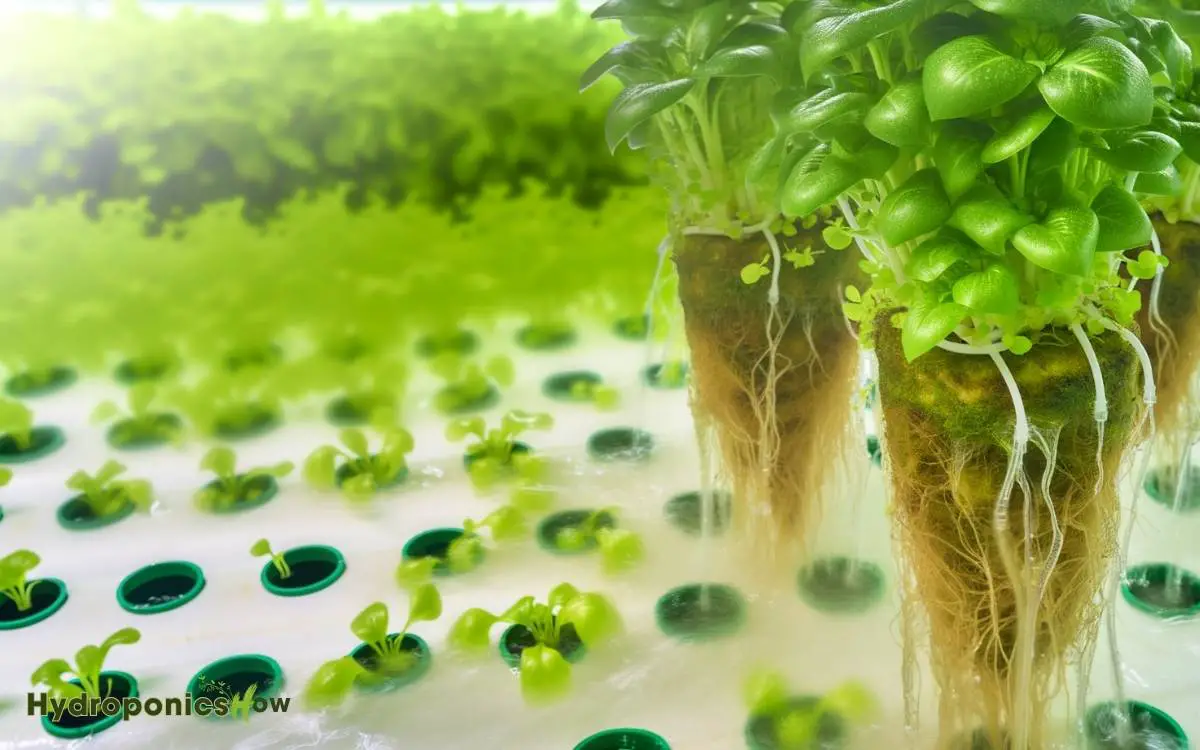
Key Takeaways
Nitrogen
Nitrogen is a critical macronutrient that directly affects the growth rate and overall health of plants in hydroponic systems.
You’ll find that nitrogen is essential for synthesizing amino acids, proteins, and chlorophyll. It plays a fundamental role in photosynthesis, enabling plants to convert light energy into chemical energy.
Data indicate that ideal nitrogen levels range between 100-150 ppm (parts per million), ensuring robust vegetative growth.
Insufficient nitrogen leads to stunted growth and chlorosis, where leaves turn yellow due to a lack of chlorophyll. Conversely, excess nitrogen can cause excessive foliage at the expense of fruit and flower production.
Regularly monitor and adjust the nutrient solution to maintain the perfect nitrogen concentration, ensuring your hydroponic plants thrive.
Phosphorus
Phosphorus plays a crucial role in hydroponics by enhancing root development, which allows plants to absorb nutrients more efficiently.
You’ll find that it greatly improves energy transfer within the plant, leading to better flowering and fruit production.
Ensuring an adequate phosphorus supply is essential for achieving peak growth and maximizing yield.
Root Development Enhancement
Proper root development in hydroponic systems hinges on maintaining ideal phosphorus levels to guarantee robust nutrient uptake and plant health.
Phosphorus is critical for root biogenesis and elongation. Guarantee your nutrient solution contains 30-50 ppm of phosphorus to optimize root growth.
Research indicates phosphorus deficiency leads to stunted roots, reducing the plant’s ability to absorb nutrients efficiently.
Conversely, excessive phosphorus can cause nutrient imbalances, particularly with zinc and iron. Monitor phosphorus concentrations regularly using precise digital meters.
Adjustments should be data-driven, based on observed root health and growth rates. Employing phosphorus-specific additives can fine-tune concentrations, ensuring optimal root development.
Achieving and maintaining these levels enhances overall plant vigor and resilience in hydroponic systems. This balance helps ensure efficient nutrient uptake, leading to stronger root systems and improved growth rates. Optimizing hydroponics for healthy plants requires careful monitoring of pH, nutrient concentrations, and environmental factors like light and humidity. By maintaining these optimal conditions, growers can maximize yields and reduce the risk of plant diseases.
Energy Transfer Efficiency
How does phosphorus boost energy transfer efficiency in plants within hydroponic systems? Phosphorus plays a vital role in energy transfer by being an integral part of ATP (adenosine triphosphate), the molecule responsible for energy storage and transfer.
In hydroponic systems, the availability of phosphorus promotes optimal ATP synthesis, enhancing the plant’s energy efficiency.
| Element | Function | Effect on Energy Transfer Efficiency |
|---|---|---|
| Phosphorus | ATP Synthesis | High |
| Nitrogen | Protein Synthesis | Moderate |
| Potassium | Ion Regulation | Moderate |
Flowering and Fruit Production
In hydroponic systems, sufficient phosphorus levels are crucial for maximizing flowering and fruit production. Phosphorus plays a critical role in energy transfer, cellular division, and development of reproductive structures.
Without adequate phosphorus, you’ll notice stunted growth, poor flower formation, and reduced fruit yield. For best results, maintain phosphorus concentrations between 20-60 ppm, depending on the plant species and growth stage.
Regularly monitor nutrient solutions using reliable testing kits to guarantee precise phosphorus levels. Imbalances can lead to deficiencies or toxicities, both harmful to plant health.
Integrating data-driven strategies, like automated nutrient dosing systems, can help maintain consistent phosphorus availability, ensuring strong flowering and fruiting phases. Employ precision techniques to achieve peak productivity in your hydroponic setup.
Potassium
Potassium plays an essential role in hydroponics by regulating water uptake and enzyme activation to optimize plant growth. You’ll find that potassium strengthens cell walls, which enhances disease resistance.
It also activates over 60 enzymes important for metabolic processes. Data shows that adequate potassium levels can improve root strength and drought resistance, leading to more robust growth.
In hydroponic solutions, maintain potassium levels between 200-400 ppm. Regularly monitor and adjust nutrient solutions to guarantee ideal concentrations.
Deficiency symptoms include chlorosis and necrosis along leaf edges. Conversely, excess potassium can cause magnesium or calcium deficiencies due to nutrient imbalances.
Utilize precise nutrient formulations to strike the right balance, ensuring your plants thrive in a hydroponic system.
Calcium
You must guarantee adequate calcium levels in your hydroponic system to facilitate cell wall development and nutrient uptake in plants.
Utilize calcium nitrate or calcium chloride as reliable sources to maintain ideal calcium concentrations.
Without proper calcium, you’ll observe stunted growth and blossom end rot, negatively impacting yield.
Calcium’s Role in Growth
Calcium plays a crucial role as a critical component in cell wall structure, promoting robust growth and stability in hydroponic plants. It plays an essential role in regulating various cellular processes, including cell elongation and division.
Without sufficient calcium, plants show stunted growth and malformed cell walls, which can compromise structural integrity.
Moreover, calcium acts as a key messenger in signal transduction pathways, influencing metabolic activities and stress responses. Studies suggest that calcium deficiencies can lead to issues like blossom-end rot in tomatoes and tip burn in leafy greens.
Monitoring calcium levels guarantees efficient nutrient uptake and overall plant health. By maintaining precise calcium concentrations, you can prevent deficiencies and encourage vigorous growth in your hydroponic system.
Sources of Calcium Hydroponics
To guarantee your hydroponic plants receive sufficient calcium, it’s essential to comprehend the different sources available for maintaining the best nutrient levels.
- Primarily, calcium nitrate (Ca(NO3)2) is a popular choice due to its high solubility and dual benefit of providing nitrogen.
- Another effective source is calcium chloride (CaCl2), known for its rapid absorption, although it must be used cautiously to avoid chloride toxicity.
- Gypsum (CaSO4) offers a steady, slow-release option, beneficial in long-term setups.
- Additionally, chelated calcium (Calcium EDTA) ensures efficient uptake, reducing the risk of deficiencies.
- Monitoring and adjusting calcium levels precisely through these sources ensures robust plant growth.
- Use a reliable EC meter to verify that calcium concentrations remain within the ideal range of 150-400 ppm.
Magnesium
Magnesium plays an essential role in chlorophyll production, directly impacting the photosynthesis process in hydroponic plants.
Without sufficient magnesium, your plants can’t efficiently convert light into energy, leading to stunted growth and poor yields.
Here’s why magnesium is important:
- Chlorophyll Formation: Necessary for photosynthesis, magnesium is the central atom in chlorophyll molecules.
- Enzyme Activation: It activates enzymes that speed up plant biochemical reactions.
- Nutrient Uptake: Facilitates the uptake and transport of other nutrients.
- Cellular Function: Crucial for cellular energy transfers, specifically ATP synthesis.
- Stress Resistance: Helps plants manage environmental stress.
Ensure you monitor magnesium levels regularly and adjust nutrient solutions to maintain ideal growth conditions for your hydroponic system. Your plants’ health and productivity depend on it.
Sulfur
Sulfur is essential for hydroponic plant growth, playing a key role in synthesizing amino acids and proteins. It’s integral to forming enzymes and vitamins, which are vital for plant metabolism.
When sulfur is deficient, you’ll notice chlorosis, especially in younger leaves, indicating impaired chlorophyll production. Ideal sulfur levels in nutrient solutions should range between 20-40 ppm (parts per million).
You should monitor sulfur concentrations using precise nutrient solution testing. Sulfur also supports the formation of essential oils and improves the overall flavor profile of crops like onions and garlic.
Keep in mind, a balanced sulfur supply enhances nutrient uptake efficiency, ensuring robust plant development. Regularly check and adjust your nutrient solution to maintain these critical sulfur levels.
Micronutrients
Micronutrients, though necessary in smaller quantities, are essential for optimizing hydroponic plant health and productivity. These trace elements play critical roles in various physiological processes.
For instance, iron aids in chlorophyll synthesis, while zinc is important for enzyme function.
You’ll need to monitor the following micronutrients closely:
- Iron (Fe): Essential for chlorophyll production and electron transport.
- Zinc (Zn): Necessary for enzyme activation and growth regulation.
- Manganese (Mn): Significant for photosynthesis and nitrogen assimilation.
- Copper (Cu): Required for reproductive growth and metabolism.
- Boron (B): Critical for cell wall formation and membrane integrity.
Ensuring a balanced supply of these nutrients will help you achieve robust plant growth and maximize yields in your hydroponic system.
Optimal Ph Levels
To optimize nutrient absorption and overall plant health in hydroponic systems, you must maintain precise pH levels.
Ideal pH ranges generally lie between 5.5 and 6.5. When pH deviates from this range, nutrient uptake efficiency drops, leading to deficiencies or toxicities.
Regularly use a calibrated pH meter to monitor your solution’s pH. If the pH is too high, add phosphoric acid; if too low, use potassium hydroxide. Consistent monitoring and adjustments guarantee that nutrients remain soluble and accessible.
Research shows that even minor pH fluctuations can have a substantial impact on growth rates and yields.
Hence, maintaining an ideal pH is critical for achieving maximum efficiency in hydroponic gardening. Keep precise records to track pH trends and make informed adjustments.
Water Quality
Guaranteeing high water quality is crucial for the success of hydroponic systems, as contaminants can significantly impact plant growth and nutrient uptake. You need to monitor and manage several key factors to maintain peak water quality.
- Total Dissolved Solids (TDS): Maintain TDS levels within the recommended range for your specific plants to avoid nutrient imbalances.
- pH Levels: Regularly check and adjust the pH to keep it within the ideal range for nutrient absorption.
- Temperature: Keep water temperature between 65-75°F to optimize root health and nutrient uptake.
- Dissolved Oxygen (DO): Ensure sufficient DO levels to prevent root diseases and promote healthy growth.
- Contaminants: Use filters to eliminate heavy metals, chlorine, and other harmful substances.
Conclusion
In hydroponics, providing essential nutrients is critical.
Did you know that plants absorb nitrogen up to 30% more efficiently in a hydroponic system than in soil?
Ensuring balanced levels of nitrogen, phosphorus, potassium, calcium, magnesium, sulfur, and micronutrients, along with ideal pH and water quality, will maximize growth.
By leveraging these precise conditions, you can achieve superior plant health and yield.
Remember, attention to detail in nutrient management directly translates to thriving, productive plants.

